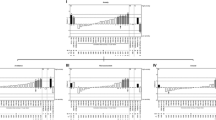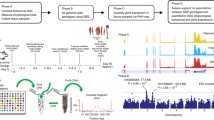Abstract
Previous research utilizing the AcB/BcA recombinant congenic strains (RCS) of mice mapped provisional quantitative trait loci (QTLs) for the psychostimulant effects of nicotine to multiple regions on chromosomes 7, 11, 12, 14, 16, and 17. The current study was designed to confirm these QTLs in an A/J (A) × C57Bl/6J (B6) F2 cross and a panel of B6.A chromosome substitution strains (CSS). The panel of B6.A CSS consists of 21 strains, each carrying a different A/J chromosome on a B6 background. The A × B6 F2, CSS, A, and B6 mice were tested for sensitivity to the effects of nicotine on locomotor activity using a computerized open-field apparatus. In A × B6 F2 mice two QTLs were identified which confirm those previously observed in the AcB/BcA RCS. Significant differences in the expression of nicotine-induced activity were associated with loci on chromosome 11 (D11Mit62) and chromosome 16 (D16Mit131) in the A × B6 F2. At the chromosome 11 QTL, an A allele was associated with lower nicotine-induced activity scores relative to the B6. In contrast, the A allele was associated with greater relative nicotine activity values for the chromosome 16 QTL. A survey of the CSS panel confirmed the presence of QTLs for nicotine activation on chromosomes 2, 14, 16, and 17 previously identified in the AcB/BcA RCS. In the informative CSS strains, A alleles were consistently associated with greater nicotine-induced activity scores compared to the B6. The results of the present study are the first to validate QTLs for sensitivity to the effects of nicotine across multiple strains of mice. QTLs on chromosomes 2, 11, 14, 16, and 17 were confirmed in CSS and/or F2 mice. Significantly, the identification of a QTL on chromosome 16 has now been replicated in three crosses derived from the A and B6 progenitors.




Similar content being viewed by others
References
Ashby CR Jr, Paul M, Gardner EL, Gerasimov MR, Dewey SL et al (2002) Systemic administration of 1R, 4S-4-amino-cyclopent-2-ene-carboxylic acid, a reversible inhibitor of GABA transaminase, blocks expression of conditioned place preference to cocaine and nicotine in rats. Synapse 44(2):61–63
Belknap JK (2003) Chromosome substitution strains: some quantitative considerations for genome scans and fine mapping. Mamm Genome 14:723–732
Buck KJ (1995) Strategies for mapping and identifying quantitative trait loci specifying behavioral responses to alcohol. Alcohol Clin Exp Res 19(4):795–801
Dewey SL, Brodie JD, Gerasimov M, Horan B, Gardner EL et al (1999) A pharmacologic strategy for the treatment of nicotine addiction. Synapse 31(1):76–86
DiPetrillo K, Wang X, Stylianou IM, Paigen B (2005) Bioinformatics toolbox for narrowing rodent quantitative trait loci. Trends Genet 21(12):683–692
Ehlers CL, Wilhelmsen KC (2007) Genomic screen for substance dependence and body mass index in southwest California Indians. Genes Brain Behav 6(2):184–191
Flint J, Valdar W, Shifman S, Mott R (2005) Strategies for mapping and cloning quantitative trait genes in rodents. Nat Rev Genet 6(4):271–286
Gelernter J, Liu X, Hesselbrock V, Page GP, Goddard A et al (2004) Results of a genomewide linkage scan: support for chromosomes 9 and 11 loci increasing risk for cigarette smoking. Am J Med Genet B Neuropsychiatr Genet 128B(1):94–101
Gelernter J, Panhuysen C, Weiss R, Brady K, Poling J et al (2007) Genomewide linkage scan for nicotine dependence: identification of a chromosome 5 risk locus. Biol Psychiatry 61(1):119–126
Gill K, Boyle AE (2005) Genetic analysis of alcohol intake in recombinant inbred and congenic strains derived from A/J and C57BL/6J progenitors. Mamm Genome 16(5):319–331
Goode EL, Badzioch MD, Kim H, Gagnon F, Rozek LS et al (2003) Multiple genome-wide analyses of smoking behavior in the Framingham Heart Study. BMC Genet 4 Suppl 1:S102
Hofstetter JR, Zhang A, Mayeda AR, Guscar T, Nurnberger JI Jr et al (1997) Genomic DNA from mice: a comparison of recovery methods and tissue sources. Biochem Mol Med 62(2):197–202
Lander E, Kruglyak L (1995) Genetic dissection of complex traits: guidelines for interpreting and reporting linkage results. Nat Genet 11:241–247
Li MD, Ma JZ, Cheng R, Dupont RT, Williams NJ et al (2003) A genome-wide scan to identify loci for smoking rate in the Framingham Heart Study population. BMC Genet 4 Suppl 1:S103
Li MD, Sun D, Lou XY, Beuten J, Payne TJ et al (2007a) Linkage and association studies in African- and Caucasian-American populations demonstrate that SHC3 is a novel susceptibility locus for nicotine dependence. Mol Psychiatry 12(5):462–473
Li MD, Lou XY, Chen G, Ma JZ, Elston RC (2008) Gene-gene interactions among CHRNA4, CHRNB2, BDNF, and NTRK2 in nicotine dependence. Biol Psychiatry 64(11):951–957
Li XC, Karadsheh MS, Jenkins PM, Brooks JC, Drapeau JA et al (2007b) Chromosomal loci that influence oral nicotine consumption in C57BL/6J × C3H/HeJ F2 intercross mice. Genes Brain Behav 6(5):401–410
Mackiewicz M, Paigen B, Naidoo N, Pack AI (2008) Analysis of the QTL for sleep homeostasis in mice: Homer1a is a likely candidate. Physiol Genomics 33(1):91–99
Manly KF, Cudmore RH Jr, Meer JM (2001) Map Manager QTX, cross-platform software for genetic mapping. Mamm Genome 12:930–932
Nadeau JH, Singer JB, Matin A, Lander ES (2000) Analysing complex genetic traits with chromosome substitution strains. Nat Genet 24:221–225
Portugal GS, Gould TJ (2008) Genetic variability in nicotinic acetylcholine receptors and nicotine addiction: converging evidence from human and animal research. Behav Brain Res 193(1):1–16
Schiffer WK, Marsteller D, Dewey SL (2003) Sub-chronic low dose gamma-vinyl GABA (vigabatrin) inhibits cocaine-induced increases in nucleus accumbens dopamine. Psychopharmacology 168(3):339–343
Singer JB, Hill AE, Burrage LC, Olszens KR, Song J et al (2004) Genetic dissection of complex traits with chromosome substitution strains of mice. Science 304(5669):445–448
Stallings MC, Hewitt JK, Beresford T, Heath AC, Eaves LJ (1999) A twin study of drinking and smoking onset and latencies from first use to regular use. Behav Genet 29(6):409–421
Stromberg MF, Mackler SA, Volpicelli JR, O’Brien CP, Dewey SL (2001) The effect of gamma-vinyl-GABA on the consumption of concurrently available oral cocaine and ethanol in the rat. Pharmacol Biochem Behav 68(2):291–299
Stylianou IM, Tsaih SW, DiPetrillo K, Ishimori N, Li R et al (2006) Complex genetic architecture revealed by analysis of high-density lipoprotein cholesterol in chromosome substitution strains and F2 crosses. Genetics 174(2):999–1007
True WR, Xian H, Scherrer JF, Madden PA, Bucholz KK et al (1999) Common genetic vulnerability for nicotine and alcohol dependence in men. Arch Gen Psychiatry 56(7):655–661
Vink JM, Willemsen G, Boomsma DI (2005) Heritability of smoking initiation and nicotine dependence. Behav Genet 35(4):397–406
Wang S, Basten CJ, Zeng ZB (2006) Windows QTL Cartographer 2.5, Department of Statistics. North Carolina State University, Raleigh, NC
Wise RA (2004) Dopamine, learning and motivation. Nat Rev Neurosci 5(6):48–94
Wise RA, Rompre PP (1989) Brain dopamine and reward. Annu Rev Psychol 40:191–225
Acknowledgment
This research was supported by funds awarded to K. J. Gill from the Canadian Institutes of Health Research (CIHR).
Author information
Authors and Affiliations
Corresponding author
Rights and permissions
About this article
Cite this article
Boyle, A.E., Gill, K.J. Genetic analysis of the psychostimulant effects of nicotine in chromosome substitution strains and F2 crosses derived from A/J and C57BL/6J progenitors. Mamm Genome 20, 34–42 (2009). https://doi.org/10.1007/s00335-008-9159-0
Received:
Accepted:
Published:
Issue Date:
DOI: https://doi.org/10.1007/s00335-008-9159-0




